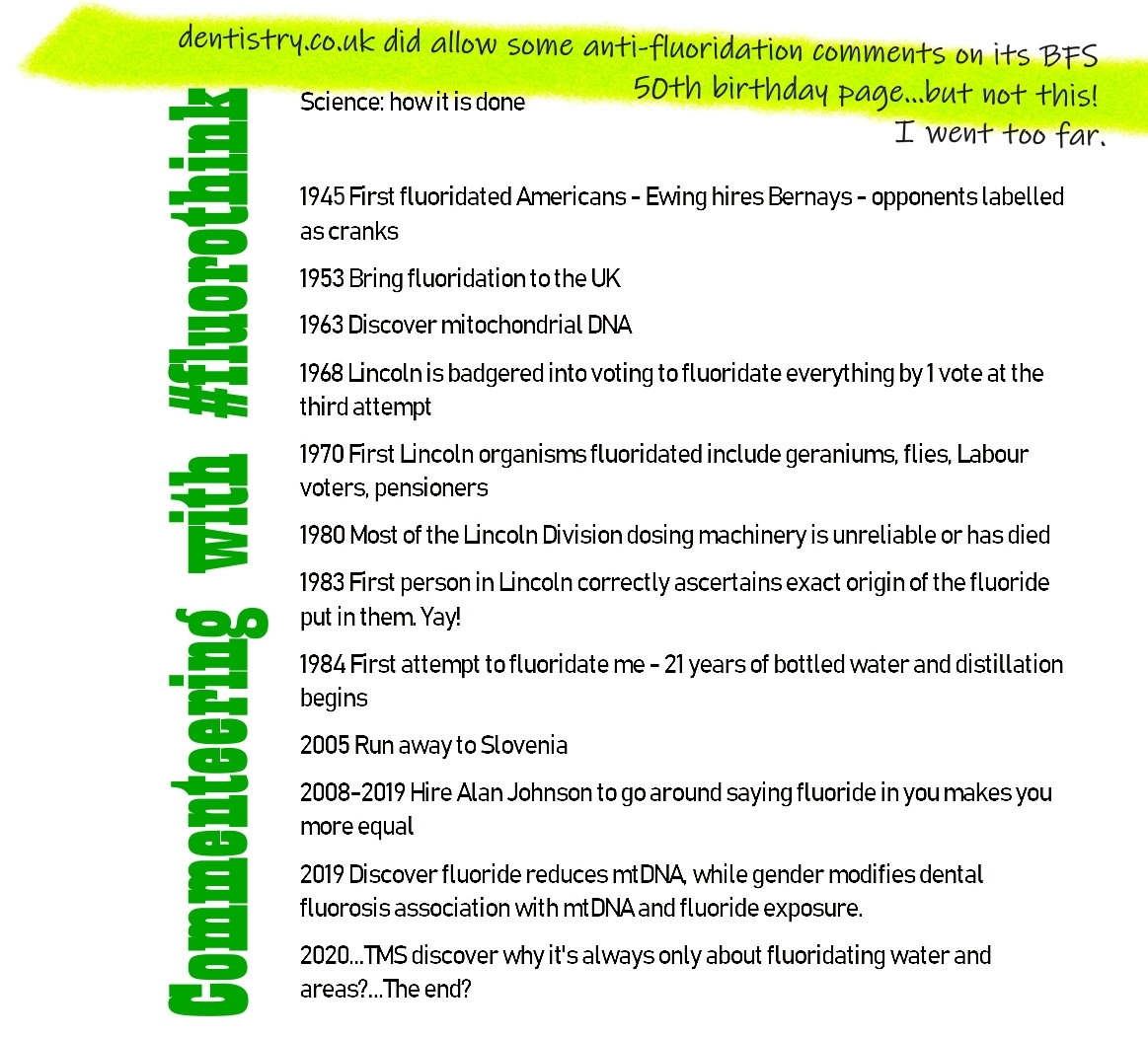

when lincoln was spiked
FLUOROTHINK IN LINCOLN 1963-1966
In the 1960s, a small group campaigned twice, unsuccessfully, to persuade Lincoln City Council to increase the population's fluoride intake from water.
In the case of the prime supply for the city, Elkesley, they were advocating a 40-fold rise over the natural concentration.
That wasn't part of the sales pitch, of course.

As we have seen, fluorothink enables sales people to proclaim systemic fluoride is a miracle treatment for teeth while simultaneously considering it to be no pharmaceutical matter.
This is as much a matter of psychological convenience as anything else. Without any water in the middle, the entire crock of shit tends to shatter in the mind of even the most ardent advocate of your chemicalisation.
It should suprise no one that the council - once it could be imagined possible that the electorate were universally incapable of looking after their own teeth without their help - would consider the views of their fluoride deposition units unimportant.
Fluorothink is alive and kicking. Because this mistake is no accident.
But what of the patients themselves? Even without fluorothink, or yet being fluoridated, Lincoln people were not minded to question what kind of relationship they had with their amateur dentists.
Did they say, "Hang on! Who are these fluoride people and how come they are depositing this stuff in me?"
Did they ask, "What if I feel the same way as former Lincoln MP Gillian Merron and I just don't want any of your unavoidable free fluoride, thanks all the same"?
No. Lincoln people did not say these things in any great number, and could not resist in any meaningful way.
Did they perhaps wonder from whence this miraculous balm was emanating?
No, they did not ask that. Opponents erroneously quoted reports of an "aluminium industry" being Lincoln's fluoride source. I was the first member of the public in Lincoln to correctly identify the actual source of what the public now contained. (NB: does not count as working, for Jobseekers' Allowance purposes).
Most were able to somehow wish it all away. As if not perceiving something was the same as it not existing.
The official story may be summarised thus: fluoride appears from nowhere, does you a huge favour, and disappears to nowhere.
But nowadays, if someone slips something in your drink, Lincoln's advice is not to let that go.
WHICH 20 people agreed to spike 100,000+ people's drinks in 1968?
This indifference to chronic drink-spiking seemed odd to me. But I wasn't from around there, and what I had thought about fluoridation up to then can be pretty much characterised as not thinking.
How did this come about? With no rioters on the streets demanding to be fluoridated, and democracy, such as it is in Lincoln, having spoken twice, you might think that was an end of the matter.
But, as seen elsewhere around the world, the fluoridationists did not take no for an answer, convinced of the ignorance of people who do not know water and areas have average teeth.
They saw it as a battle of attrition against an irrational mass (you). And the Council was in the way.
Thanks to a steady drip of fluorothink the almost entirely medically- and scientifically-unqualified Lincoln councillors eventually voted to treat the population.
After being steadily goofed by a tricky use of language, coerced by appeals to emotion and authority, and absolved by woolly and/or legalistic thinking of responsibility, these slowly boiled frogs came to think the electorate were water... or an area.
These are the pro-voters who gave way to
fluorothink's third attempt in 1968, when it was passed by one vote.
Frederick Thomas Allen
Robert Gordon Bracey
Sidney Alfred Campbell
Frank Roy Eccleshare
David John Fowler
Francis Edward Henry Horn
Richard Derek Horner
Charles Ireland
Bernard Harry Kendall
Richard Murfin Lucas
Adelaide Joyce Naftalin
Wilfred Pixsley
Richard John Read
Eric Jordan Richardson
Cecil Percy Robinson
Peter Roe
John Greenfield Ruddock
Mary Robena Sookias
Alfred Herbert Taylor
Sheila Joan Townend
Lincoln in the 1960s. By obtaining its water from out of town instead of next to its shit pit, Lincoln's typhoid epidemics finally died down by WW1 - as Lincoln hitched its star to industrialised mud-and-blood warfare by developing the first tank. Other local industries connected with blowing things up include air nuking, ship-gunning, religion and radiation hardened chips.
WHAT DID THE SPIKERS TELL THE SPIKEES ABOUT THE SPIKING AT THE TIME?
From November 2019, dedicated fluoride-heads will be able to see how Lincoln's fluorothink showboat set sail, in these hard-won transcripts of media reporting from the sixties.
As far as their being fluoridated went, these reports were all the public had to go on, in those clodhopping, internetless days.
Don't get too excited about what you may learn from these. The naivité shown in these reports speaks for itself, and is of its time. Fluorothink exudes oleaginously and unapologetically from the outset.
Thanks to the technological miracle of microfiche - and Lincoln Central Library not being able to cut holes in it and lose items like it has the City Council's minutes around the final vote - this uniquely bland timeline of fluorothink's misleading advertising in part of the East Midlands is probably now the best chance of understanding how people came to be chemically altered for their entire lives by manipulative sales patter of such a comically facile variety.
It is also much easier to see what can and cannot be believed in press coverage, when a subject history like this is assembled. To get that, back then, you would need to subscribe to an expensive professional press cuttings service.
Sadly, my enthusiasm for scanning years of unindexed newspaper articles paused at the Dec 1966 mark and was never regained.
But is safe to assert that neither by the time I arrived in Lincoln 11 years A.F., in 1981, nor subsequently, no media ever mentioned let alone explained the fertiliser industry's connection with fluoride, or anything about fluoride air pollution, or gypsum ponds or fluoride waste disposal problems.
That was their magic sauce in those days. The public didn't know anything and nobody told them anything.
All jolly British.
Some time after I had arrived and begun to examine the crime scene, the Council began flirting with public Q&A sessions, but quickly invented rules to prevent any on their spiking incident. Which continues to this day.
There are no fluoridated people mentioned in the reports. But plenty of water, which occurs 161 times. This misdirection is key to fluorothink.
You will find nothing inside concerning blood, enzymes, total intake, urine testing, or safe limits in mg/kgBW/day. Readers are never confused with technical words like "fluorosis".
The word "skeletal" appears once. Ologies are markedly absent.
And although, from the 1980s until I bade farewell and good riddance to Lincoln, Britain, and its fluoridating councillors in 2005, I gave local outlets such as the Lincolnshire Echo many opportunities to do so, there was never anything in the Lincolnshire media about the now-fashionable neurodevelopmental harms of fluoride.
These were ALL the articles I could find covering 1963-1966. And what makes this significant in my opinion are the hundreds of fluoride-related topics they do NOT discuss.

I typed up these news reports in 1989 on an Amstrad PCW8512 8-bit computer and printed them on a Star 24-pin dot matrix printer.
I just got round to scanning them in. Sorry about the 30-year wait, but these quaint 1960s examples of fluorothink have matured nicely, like old cheese, ready for comparison with mass-psychological manipulation's better-known triumphs of Brexit and Trump. If you want it quicker next time, pay!
It was certain that nobody else was going to do it, so I undertook the mundane but vital job, of recording for posterity these official distortions about Lincoln City Council's chemical improvement of the biosphere.
I was collecting every kind of information I could get. I wanted to understand their baffling meander into darkness. I wanted completeness.
Fluoridation (good or bad) is a long term drug.
My archive's cheap design belies its 56 years in the making.
This dreary but necessary collection is a long-term creation soldered together in a fusion of fluoridation and information technology histories, and now a European and global story in which meanings - and clearly meaningless assurances - have been carted from the era of newsprint and diode transistor logic circuits down the decades to the corporation-sodden internet of today.

There's no copy-paste on microfiche. But somehow the story made it through.
You can even see the printer ribbons wearing out during these reports - and everything they don't contain - in these searchable pdfs
Julian Bohan
2 November 2019